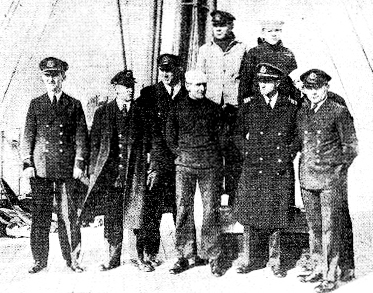On Wednesday, January 23, 1929, the S.S. America was returning from France bound for New York. The weather was terrible and was only bound to get worse. It was late afternoon when an S.O.S. was received by the ship’s radio room from the Italian freighter S.S. Florida. The America’s captain, George Fried calculated its position and steamed towards the stricken ship. At 6:10 pm, she came into view, about 700 miles off the coast of Virginia. The America pulled to within a quarter of a mile of the sinking ship. In quick order, John M. Harrobin, 31-years-old at the time and expert lifeboat man, volunteered as part of the rescue team. He readied the lifeboat for action and soon the eight man crew embarked on one of the most dangerous and thrilling rescues ever accomplished on the high seas.
Within minutes of lowering the boat from the massive steamship, a violent gale hit and the storm that had crippled the S.S. Florida returned with a vengeance. Just keeping the lifeboat upright was going to require the utmost skill. The oarsman rowed and rowed, fighting the rough sea, lucky to make any progress with each pull of the oars. Getting closer, they could see that the Florida was lying on her side. It was miraculous that she had not capsized as she wallowed in the ice strewn sea. Five of her six lifeboats had been crushed and the sixth had washed away. Snow was falling on the nearly frozen crew, tenuously clinging to the heavily listing ship. They had been stranded for 60 hours.
Unable to come alongside the Florida, instead the men had to get a line from the lifeboat to the ship. Chief Storekeeper Salvatore Bracco from Union, New Jersey, was onboard and shouted instructions to the Italian crew on the Florida, “Avanti…avanti…un al turno!” The crew members then entered the freezing water to make their way, hand-over-hand, to the lifeboat. Through this horrific struggle, 17 of the Florida crewmembers were rescued, but a surge of the sea caused the line to be lost and precious moments were needed to get another one to the foundering vessel. When the rescue resumed, another 15 men were saved, the last of whom was the ship’s captain.
By the time the lifeboat, now containing 40 men, was to return to the America, the storm was at its worst. The return proved to be both harrowing and treacherous. At last, three hours after having set out, the lifeboat reached the side of the America. Every conceivable method – from ladders to make-shift hoists, were used to get the men, some of whom were badly injured, on board the America.
When the America reached port in Hoboken, news of the rescue had already spread and a crowd of nearly 10,000 people lined the streets to welcome the rescue ship. The following day, the America’s crew received a ticker tape parade down New York City’s “Canyon of Heroes” and a formal greeting at New York’s City Hall.
Able Seaman John M. Harrobin had parades in his honor in Scranton and Jessup, Pennsylvania, while medals for bravery were bestowed on him by the governments of France, Italy, the United States and one from New York City Mayor James Walker. All are framed proudly displayed at the Harrobin home.
The story was submitted by John J. Harrobin, as told to Katherine Del Russo Harrobin




